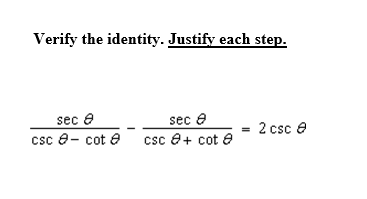Given:
sec(theta)/(csc(theta)-cot(theta))-sec(theta)/(csc(theta)+cot(theta)) = 2csc(theta)
Multiply the first fraction by 1 in the form (csc(theta)+cot(theta))/(csc(theta)+cot(theta))
sec(theta)/(csc(theta)-cot(theta))(csc(theta)+cot(theta))/(csc(theta)+cot(theta))-sec(theta)/(csc(theta)+cot(theta)) = 2csc(theta)
This makes the denominator become the difference of two squares:
(sec(theta)(csc(theta)+cot(theta)))/(csc^2(theta)-cot^2(theta))-sec(theta)/(csc(theta)+cot(theta)) = 2csc(theta)
This particular difference of two squares is the left side of the identity csc^2(theta)-cot^2(theta) = 1, therefore, the denominator becomes 1 and disappears:
sec(theta)(csc(theta)+cot(theta))-sec(theta)/(csc(theta)+cot(theta)) = 2csc(theta)
Use the identities sec(theta)csc(theta) =1 and sec(theta)cot(theta) = csc(theta):
1+csc(theta)-sec(theta)/(csc(theta)+cot(theta)) = 2csc(theta)
Multiply the next fraction by 1 in the form (csc(theta)-cot(theta))/(csc(theta)-cot(theta))
1+csc(theta)-sec(theta)/(csc(theta)+cot(theta))(csc(theta)-cot(theta))/(csc(theta)-cot(theta)) = 2csc(theta)
The produces the same difference of two squares, therefore, we shall merely delete the numerators:
1+csc(theta)-sec(theta)(csc(theta)-cot(theta)) = 2csc(theta)
Use the identities sec(theta)csc(theta) =1 and sec(theta)cot(theta) = csc(theta):
1+csc(theta)-1+csc(theta) = 2csc(theta)
Combine like terms:
2csc(theta) = 2csc(theta) Q.E.D.

